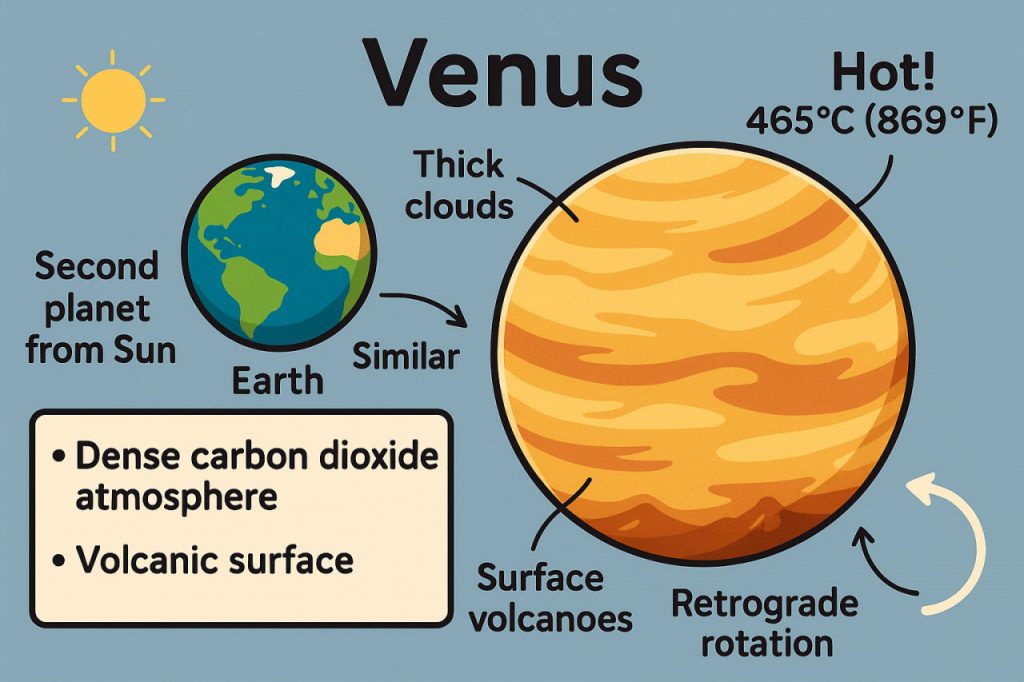Venus is the second planet from the Sun and is often called Earth’s “twin” due to its similar size and composition. However, beneath its cloudy veil, Venus is a scorching, hostile world that differs drastically from our own. Despite its beauty in the night sky, it is one of the most extreme environments in the Solar System.
Basic Characteristics of Venus
- Distance from the Sun: ~108 million km
- Diameter: 12,104 km (about 95% the size of Earth)
- Length of day: 243 Earth days (a Venus day is longer than its year!)
- Atmosphere: Thick, mostly carbon dioxide
- Surface temperature: About 465°C (869°F) – hotter than Mercury
Why Is Venus So Hot?
Venus has an incredibly thick carbon dioxide atmosphere, more than 90 times the pressure of Earth’s. This creates an intense greenhouse effect, trapping heat and raising surface temperatures far beyond what would be expected based on its distance from the Sun.
Its clouds are composed of sulfuric acid, and no water exists on the surface. The result is a world where lead would melt, and any spacecraft that lands survives only a few hours.
The Mysterious Rotation
Venus rotates backward (retrograde rotation) compared to most planets. Also, a day on Venus is longer than a year—243 Earth days to rotate once, but it orbits the Sun in just 225 Earth days. This strange spin is still a subject of study among scientists.
Surface and Geography
Despite being hidden beneath clouds, radar mapping has revealed a rocky surface with:
- Vast plains
- Volcanic mountains
- Craters
- Large plateaus
There is evidence that volcanic activity may still be occurring today.
Exploration of Venus
Venus was one of the first planets visited by spacecraft:
- Venera missions (Soviet Union): First successful landings and surface images
- Magellan mission (NASA): Mapped 98% of the surface using radar
- Future missions: NASA’s VERITAS and ESA’s EnVision aim to explore Venus in greater detail
Despite extreme conditions, Venus remains a target for exploration because it offers insights into:
- Climate change and greenhouse effects
- Geology of rocky planets
- Why Earth remained habitable and Venus did not
Can Venus Support Life?
Due to the extreme temperatures and acid clouds, life as we know it cannot survive on the surface. However, some scientists have speculated that microbial life might exist in the cooler upper layers of the atmosphere—though this remains unproven.
Conclusion
Venus is a planet of contrasts: similar to Earth in size and composition but vastly different in climate and atmosphere. Studying Venus helps us better understand our own planet’s future, the mechanics of planetary systems, and the consequences of a runaway greenhouse effect.
Glossary
- Greenhouse Effect: Warming that occurs when gases trap heat in a planet’s atmosphere
- Retrograde Rotation: Spinning in the opposite direction of most planets
- Carbon Dioxide (CO₂): A gas that traps heat and is a major greenhouse gas
- Radar Mapping: Using radio waves to see through clouds and map a planet’s surface
- Microbial Life: Life in the form of microscopic organisms


